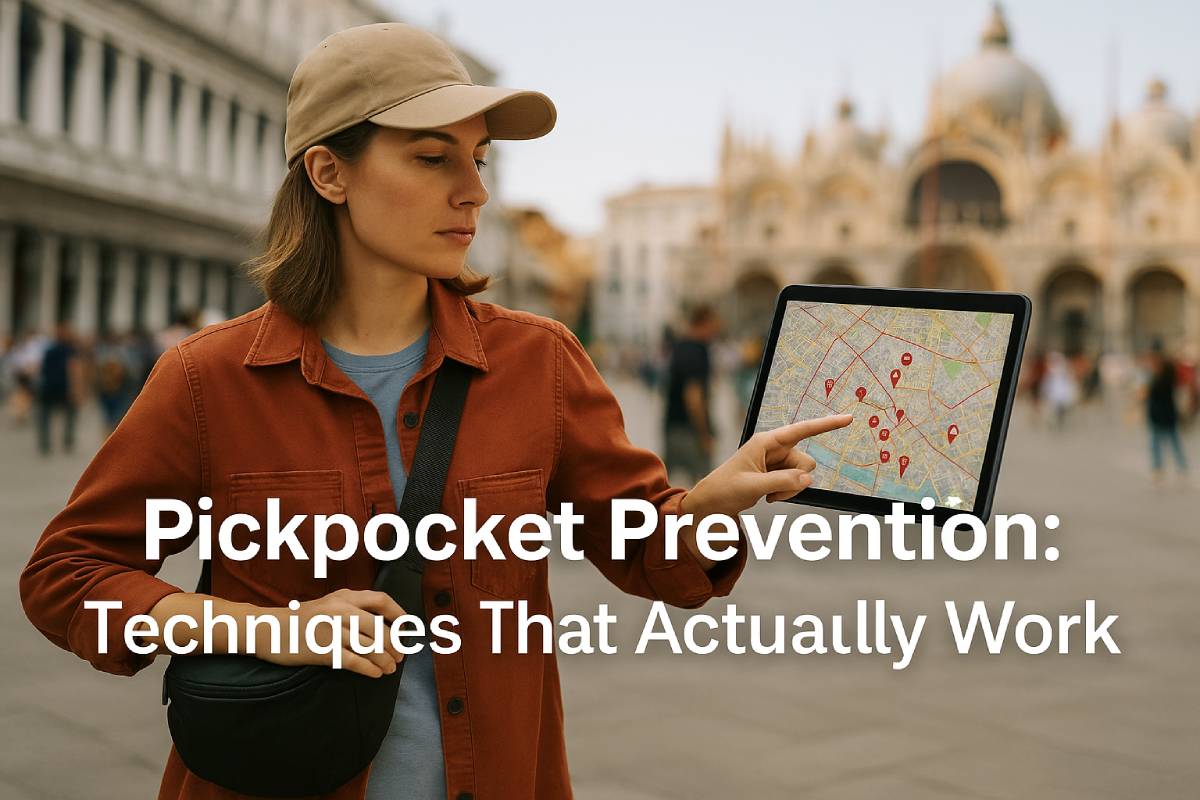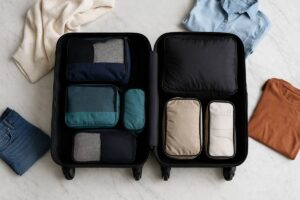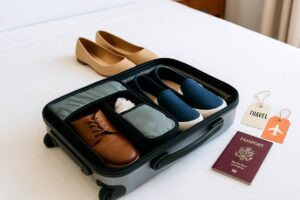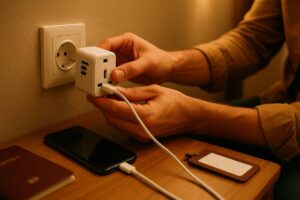Pickpocket prevention is your #1 travel safety priority because opportunistic thieves target distracted tourists in bustling attractions, turning dream vacations into stressful ordeals.
By mastering proven anti-theft techniques—zippered compartments, RFID-blocking gear, and concealed pockets—you’ll safeguard your valuables without sacrificing convenience.
In this guide, you’ll learn comprehensive pre-trip prep, from researching high-risk neighborhoods and securing robust travel insurance to understanding local cultural cues.
We’ll recommend top-rated slash-proof straps and locking zippers for bags, share tips on confident body language and situational awareness to deter pickpockets, outline discreet on-the-ground tactics for crowded markets and public transport, and walk through emergency steps, like freezing cards and reporting incidents, to help you recover swiftly if theft occurs.
Pre-Trip Preparation
Effective pre-trip pickpocket prevention is rooted in targeted destination research, consulting official travel advisories, and crime maps to identify high-risk neighborhoods and safe transport routes.
Choosing a travel insurance plan with robust anti-theft coverage (e.g., reimbursement limits of $250 per item and up to $150 for document replacement)—preparing digital and paper backups of passports and cards to expedite emergency replacements.
Verifying lodging safety features like in-room safes and reliable door locks, and cultivating cultural awareness—adapting dress codes and local etiquette to blend in and avoid marking yourself as a tourist.
These pillars of travel safety and anti-theft techniques form the essential foundation for any savvy globetrotter’s pre-departure checklist.
Effective pickpocket prevention begins before you pack, with research into local crime rates, lodging safety features, and cultural norms.
Destination Research
Identify high-risk neighborhoods, typical scam tactics, and safe transport routes.
- High-risk neighborhoods: Consult government travel advisories to pinpoint areas with elevated pickpocket activity—central Rome, Barcelona’s La Rambla, and Paris’s Latin Quarter frequently top the lists.
- Typical scams: Learn common tactics like the “spill-and-rush” distraction and fake petition schemes used to divert attention.
- Safe transport routes: Map recommended corridors and licensed services—arrange airport transfers in advance and favor well-lit bus or metro lines vetted by official sources (travel.state.gov).
Travel Insurance & Documentation
Choose a policy covering stolen items; carry digital and paper copies of passports and cards.
Select a travel insurance plan that explicitly reimburses stolen baggage and personal items, noting per-item limits (often $250) and specialty coverage for valuables. Review exclusions for high-value possessions like jewelry to decide if you need additional riders
| Coverage Type | Typical Limit |
|---|---|
| Jewelry stolen | $8,000 |
| Per-item theft | $250 |
| Document replacement | $150 |
- Digital & paper copies: Store scanned passports and cards securely in the cloud or encrypted phone folder, and tuck printed backups in separate luggage compartments to streamline replacements and claims if originals are lost or stolen.
Cultural Awareness
Learn local etiquette and dress codes to blend in and avoid marking yourself as a tourist.
- Dress codes: Research regional norms—cover shoulders and knees in conservative areas, remove hats indoors, and choose neutral colors to reduce visibility as a traveler.
- Behavioral cues: Observe local greetings, personal space expectations, and acceptable noise levels to avoid drawing unwanted attention.
- Visual blending: Ditch overtly branded gear and flashy camera straps; opt for unobtrusive accessories that mirror resident style.
Anti-Theft Travel Gear
In our review of anti-theft travel gear, we found that slash-proof straps, locking zippers, and RFID-blocking pockets are essential features for backpacks, while front-pocket wallets and discreet money belts offer secure carry options without drawing attention.
Tested models like the Pacsafe Metrosafe LS450 and XD Design Bobby lead the pack for durability and hidden compartments.
For valuables on your person, Peak money belts with built-in RFID lining and recovery services have proven effective, reimbursing up to $250 per item, while Travelambo and Rick Steves’ Civita wallets balance stealth with capacity.
Complement these with Pacsafe steel-cable locks and Sabre door-stop alarms for lodging security, and don’t forget RFID blocking sleeves—sets of 3–12 replaceable sleeves shield cards from electronic scanning. Below is a detailed breakdown of each category and our top recommendations.
Choosing the right gear is your first line of defense—look for tested anti-theft bags, wallets, and accessories.
Anti-Theft Bags & Backpacks
- Slash-Proof Straps & Fabric: Prevents cut-and-run tactics; found on Pacsafe and Travelon models.
- Locking Carabiners & Zippers: Devices like Pacsafe’s PopNLock and TurnNLock clips secure bags to fixed objects.
- Hidden Compartments & RFID Pockets: Internal RFID-blocking pockets and concealed exterior pockets keep cards and passports safe.
- Top Models:
- Pacsafe Metrosafe LS450: 25 L, locking zips, steel cable, RFID pocket.
- XD Design Bobby: Cut-proof fabric, discrete zipper placement, reflective trim
- Inateck 42 L Antitheft Laptop Backpack: 17″ laptop sleeve, inexpensive cut-resistant fabric.
Secure Wallets & Money Belts
- Front-Pocket Wallets: Slim designs sit in your front pocket, reducing grab-and-dash risk; e.g., Travelambo RFID wallet.
- Neck Pouches & Belt Wallets: Discreet under-clothing options by Rick Steves (Civita series) start at $14.99.
- Built-In RFID Protection: Peak Money Belt includes RFID lining and $250 theft protection per item.
- Comfort & Capacity: Look for lightweight, moisture-wicking materials with multiple compartments (amazon.com).
Additional Accessories
- Cable Locks: TSA-approved retractable steel cable locks like Pacsafe Retractasafe 250 and Forge’s cable locks deter opportunistic theft (amazon.com).
- Portable Door Alarms: 130 dB alarms (Sabre Door Stop, Securityman) alert you to unauthorized entry in hotel rooms or rentals (amazon.com).
- RFID-Blocking Sleeves: Sets of 3–12 sleeves by Boxiki or Travelon block electronic skimming and fit into any wallet or bag pocket (amazon.com).
- Other Essentials: Mini combination locks, cable tethers, and mesh nets for hostels—consider weight and ease of use.
Packing Checklist
| Item | Recommended Model | Key Feature |
|---|---|---|
| Anti-theft Backpack | Pacsafe Metrosafe LS450 | Under-clothing carries, discreet design |
| Anti-theft Backpack | XD Design Bobby | Cut-proof fabric, hidden zippers |
| Front-Pocket Wallet | Rick Steves Civita Moneybelt (front-pocket) | Underclothing carries, discreet design |
| Money Belt | Peak Money Belt | RFID lining, $250 theft protection |
| Cable Lock | Pacsafe Retractasafe 250 | Retractable steel cable |
| Portable Door Alarm | Sabre Door Stop Alarm | 130 dB motion-triggered alarm |
| RFID Blocking Sleeves | Boxiki Set of 12 | Tear- and water-resistant, color-coded |
This curated selection of anti-theft bags, secure carry options, and accessories will give you confidence and convenience on every journey, turning pickpocket prevention into a seamless part of your travel routine.
Body Language & Situational Awareness
Adopting a vigilant stance through regular 360° scans—performing a quick 10-second sweep every few minutes—allows you to map potential threats in crowded areas before they strike. Pair this with confident movement—walking with purpose, making brief eye contact, and avoiding fumbling—to project alertness and disrupt opportunistic thieves.
Finally, stay ahead of crowd-surf tactics like the sandwich, bottleneck, and spill scams by knowing these common ploys and recognizing them early.
Confident posture, regular environment scans, and proactive awareness significantly reduce your attractiveness as a target.
360° Scanning
Developing a routine of scanning your surroundings every few minutes helps you notice anomalies—from lingering individuals to surreptitious team movements. The Constellation Group emphasizes that this technique allows you to identify pickpocket rings posing as street performers or beggars before they close in.
Confident Movement
Adopting a purposeful gait and elevated posture projects confidence, signaling to potential thieves that you’re not an easy target. According to Global Rescue, making brief but deliberate eye contact conveys vigilance and deters opportunists looking for distracted travelers.
Crowd-Surf Tactics
Pickpockets often work in groups, employing crowd-surf tactics to divert your attention—techniques like the sandwich, bottleneck, and actor rely on close proximity and distraction to conceal the theft. Remaining aware of these methods helps you avoid scenarios where your guard is down, especially in tourist hotspots and on public transit.
| Distraction Technique | Description |
|---|---|
| Sandwich | Two thieves create a “sandwich” to crowd you and pick your pocket without detection |
| Bottleneck | A thief blocks a narrow passage then bumps you, allowing an accomplice to steal while you’re distracted |
| Actor | A scammer stages a scene (argument, dropped money) to capture your attention and mask the theft |
By integrating these nonverbal tactics—systematic 360° scanning, purposeful movement, and recognition of crowd-surf distractions—into your travel routine, you’ll markedly lower your risk of falling victim to pickpocketing.
Bag & Wallet Security Methods
Front-crossbody bags are consistently rated among the top anti-theft solutions by travel gear experts at Forbes and The Points Guy, thanks to their hands-on control and secure zipper placement.
On-body backpacks offer bulk storage and slash-resistant features, but should be rotated to the front in crowded settings to maintain visibility and deter thieves.
Securing compartments with small cable ties, mini padlocks, or DIY rubber-band hacks adds time and complexity that discourages pickpockets, as noted by Packing Light Travel and TSA reports on luggage theft.
Hidden layers—such as stashing emergency cash or backup cards under shoe insoles or in concealed clothing pouches—provide a reliable fallback when primary defenses are breached, endorsed by both travel insurance advice and veteran backpackers.
How you carry and secure valuables is as important as the gear itself.
Carry Methods
- Front-Crossbody Bags: Worn across the chest, these keep zippers and pockets in your line of sight, reducing grab-and-run thefts; top picks include the Travelon Anti-Theft Classic Mini and Pacsafe Citysafe CX.
- On-Body Backpacks: Offer greater capacity and slash-resistant fabric, but in busy markets or transit, swivel the pack to your front to maintain control and visibility.
- Hidden Pouches: Neck wallets, money belts, and under-clothing spandex pouches keep passports and cash concealed under layers, ideal during airport screening or peak tourist hours.
Securing Compartments
- Cable Ties: TSA-approved Secure-A-Bag ties thread through zipper pulls, creating a visible seal that thieves bypass for easier targets (amazon.com).
- Mini Padlocks & Cable Locks: Small combination or key locks (e.g., Pacsafe Retractasafe) and retractable steel cables anchor bags to fixed objects, delaying theft attempts (youtube.com).
- DIY Hacks: Twist-ties or rubber bands looped through zipper pulls add crucial seconds to deter casual thieves without specialized gear.
Hidden Layers
- Shoe Insoles: Place folded cash in a small zip-top bag under your shoe’s insole to safeguard emergency funds, a tactic endorsed by Packing Light Travel and long-haul backpackers.
- Clothing Pouches: Sewn-in pockets in belts, jackets, or bras keep cards and cash close to the body and out of view, blending seamlessly with everyday attire.
- Diversion Safes: Disguised containers—like empty sunscreen tubes or lip balm cases—offer an extra layer of concealment for small valuables, recommended by savvy travelers.
| Method | Example Tool/Item | Key Benefit |
|---|---|---|
| Front-Crossbody Bag | Travelon Anti-Theft Classic Mini | Hands-on zipper control |
| On-Body Backpack | Pacsafe Venturesafe EXP45 | Slashproof fabric, locking zips |
| Cable Tie Seal | Travelon Secure-A-Bag Cable Ties | Visible tamper evidence |
| Mini Padlock | TSA-approved combination lock | Delays theft attempts |
| Shoe Insole Stash | DIY zip-top bag under insole | Emergency cash concealment |
| Clothing Pouch | RFID money belt or jacket pocket | Covert carry under clothing |
By combining these carry methods, compartment locks, and hidden-layer tactics, you’ll turn your bag and wallet into formidable defenses, keeping pickpockets at bay and your travels worry-free.
Transportation-Specific Advice
Pickpockets exploit the unique vulnerabilities of every transport mode—airports, trains, buses, and ride-shares—turning crowded queues and distracted moments into easy theft opportunities.
Globally, pickpocketing incidents exceed 400,000 per day, with airlines reporting cases of “sleeping flyer” thefts mid-flight and busy terminals serving as prime hunting grounds.
By keeping carry-ons zipped and within sight, using TSA-approved locks and RFID-blocking sleeves, situating bags strategically on trains and buses, and carrying valuables on your person during taxis and rideshares, you can dramatically reduce your risk and travel with confidence.
Pickpockets exploit crowded trains, buses, and airport queues—adapt your tactics accordingly.
Airports & Planes
Airports and in-flight environments present unique risks: thieves target unattended carry-ons during security lines or when passengers nap at their seats. Locking your luggage with TSA-approved locks deters casual in-flight theft—those extra seconds often send pickpockets packing.
Always keep your carry-on zipped and within sight, whether overhead or at your feet, to prevent grab-and-run incidents (explore.com).
Finally, RFID-blocking sleeves or wallets thwart electronic skimming at crowded checkpoints without delaying your security screening, since most RFID wallets pass through X-rays unobstructed.
| Action | Benefit |
|---|---|
| Keep carry-on zipped & in sight | Reduces unattended bag thefts |
| Use TSA-approved locks | Deters opportunistic thieves onboard |
| Employ RFID-blocking sleeves | Prevents electronic skimming |
Trains & Buses
Crowded platforms and packed carriages are ideal pickpocket arenas—stay proactive to protect your gear. Sit with your bag between your feet or strap it securely to your chair, ensuring it remains in your physical control at all times.
On long rides, use lockable bag straps to anchor your luggage to seat frames and avoid overhead racks if you can’t monitor them continuously. These simple steps keep your valuables in view and out of reach from grab-and-dash thieves.
| Tactic | Risk Mitigated |
|---|---|
| Keep bag within direct sight | Prevents quick grab-and-run |
| Secure the strap to the chair | Anchors bag in place |
| Avoid overhead racks | Keep the bag within direct sight |
Taxis & Rideshares
In taxis and rideshares, your body is the safest vault. Keep valuables on your person—in front pockets or hidden pouches—rather than stashing them in door-side compartments or trunks, where they’re easy targets if the vehicle stops unexpectedly.
Before you ride, research and choose licensed, reputable services, ideally app-based options with ride-tracking features to deter unauthorized drivers and provide trip records.
| Practice | Benefit |
|---|---|
| Keep valuables on your person | Lowers the risk of unregulated drivers |
| Avoid door-pocket storage | Prevents easy grabs during entry/exit |
| Use licensed ride-share services | Lowers risk of unregulated drivers |
By tailoring your approach to each transport environment—anchoring your gear in airports, locking it down on trains and buses, and carrying it on your person in taxis—you transform potential weak points into fortified defenses, making pickpocket prevention a seamless part of your journey.
Tourist Hotspot Warnings
Europe’s most famous squares and markets double as pickpocket playgrounds, with Rome’s Trevi Fountain topping the list at 478 mentions per million British visitors, followed by Paris’s Eiffel Tower at 251 per million, Barcelona’s Las Ramblas at 111, and Amsterdam’s Red Light District at 100.
EU police logged over 5.3 million theft cases in 2023—a 4.8% rise year-on-year—underscoring how cultural hotspots and crowded streets fuel rising pickpocket risks. Common distractions—“spill-and-rush,” fake petition drives, unsolicited photo offers—rely on moving your focus away from belongings, often executed by coordinated teams of thieves.
Meanwhile, destination-specific tricks like Paris’s “Kick Cup” scam, where a cup of coins is placed in your path to draw you into a crouch, and Barcelona’s professional pickpocket rings operating in groups of two or more, illustrate the evolving tactics that savvy travelers must anticipate (reddit.com).
Iconic landmarks and busy markets are prime hunting grounds—know what to watch for in each locale.
High-Risk Areas
Major public squares, street festivals, and crowded shopping districts see the bulk of theft reports.
| Destination | Mentions of Pickpocketing per Million Visitors |
|---|---|
| Trevi Fountain, Rome | 478 |
| Eiffel Tower, Paris | 251 |
| Las Ramblas, Barcelona | 111 |
| Brandenburg Gate, Berlin | 111 |
| Red Light District, Amsterdam | 100 |
Common Scams
Scammers deploy simple yet effective ploys to distract you from your valuables.
- Spill-and-Rush: A “clumsy” thief spills a drink or coin, prompting you to help clean up while an accomplice lifts your wallet.
- Fake Petition Drives: Someone asks you to sign a petition or survey; as you focus on the clipboard, your belongings get rifled.
- Unsolicited Photo Offers: A “friendly” stranger offers to take your picture, taking your camera or phone out of sight for the perfect shot, then vanishes with it.
- Overly Friendly Bystanders: Beggars or “helpers” approach you closely, sometimes with a child in tow, while an accomplice picks your pocket in the crowd.
Local Variations
Different cities have signature scams reflecting local pickpocketing traditions.
Paris “Kick Cup” Scam: Tourists walking past a café or plaza stumble over a coin-filled cup deliberately placed in their path. When you bend to retrieve it, team members circle in to loot your pockets or bag pockets. This trick persists around the Louvre and Champs-Élysées, where busy foot traffic and guilt at “damaging” someone’s money drive compliance.
Barcelona Pickpocket Rings: In Barcelona’s Gothic Quarter and El Born, organized crews of two to four pickpockets coordinate roles—one distracts you with a question or a fake jammed metro door, while partners extract cash or phones. Recent local data show 250 thefts at El Born Night Market in just three months of 2024, illustrating how quickly these rings can operate in high-traffic zones.
By understanding which sites draw the most pickpocket activity, recognizing common distraction scams, and noting each city’s signature tricks, you’ll be equipped to keep your belongings—and your travel memories—secure.
Hotel & Accommodation Security
Just as 78% of travelers cite hotel security as a top concern when choosing accommodations, it’s vital to fortify your room beyond the standard lock-and-key to prevent thefts that spike in even the safest properties.
Police records from Southern California show a marked increase in room burglaries—six guests hit in one Paris hotel alone—underscoring that thieves will strike when you’re least expecting it, often while you sleep.
Portable door locks have been shown to stop unauthorized entry even if someone holds a copy of your key or access card, making them an indispensable travel companion.
Though in-room safes see few reported breaches—only about 20 room burglaries occur annually in Miami-Dade, with no safe‐specific losses—it’s still wise to use both in-room and front-desk safes for valuables, backed by strong, unique PINs.
Your room should be a sanctuary—add layers of protection beyond the deadbolt.
Door Security
- Portable Door Locks: Lightweight, easy-to-install locks create a secondary barricade, preventing entry even if thieves possess your room key or access card.
- Door Wedges & Alarms: Rubber wedges and 130 dB door-stop alarms jam inward-opening doors and alert you to forced entry attempts, deterring most intruders before they try.
- Peephole & Chain: Always engage the deadbolt and any built-in chain or latch; if missing, request a chain from the front desk or improvise with a sturdy travel cable lock to loop through the strike plate.
Safe Usage
- In-Room Safes: Though safe-specific thefts are rare, use the in-room safe for medium-value items like jewelry and small electronics, setting a random, non-obvious PIN to resist casual tampering.
- Front-Desk Safes: For passports, extra cash, and irreplaceable documents, the front-desk safe offers institutional security and monitoring—store these items there instead of risking them in your room.
- Complementary Storage: Keep duplicates or emergency funds in a hidden pouch or secondary safe layer (e.g., a travel belt), ensuring you retain access if one storage method fails.
| Item | Storage Location | Benefit |
|---|---|---|
| Passports & vital docs | Front-desk safe | Monitored, high-security access |
| Jewelry & small electronics | In-room safe | Immediate access, moderate deterrence |
| Emergency cash & backup cards | Hidden pouch under mattress or travel belt | Hidden pouch under the mattress or travel belt |
Check-In Protocols
- Room Number Confidentiality: Never announce or display your room number in public; keep the keycard in a wallet or RFID sleeve to prevent skimming or accidental disclosure.
- Floor Selection: Opt for rooms on the 3rd–6th floors to balance security and fire-escape accessibility—ground-floor rooms see more break-ins, while higher floors complicate emergency egress.
- Tampering Inspection: Upon entry, perform a “safety sweep”—check closets, under beds, and behind curtains using a hanger or flashlight to spot hidden intruders or altered locks; report any damage or irregularities to the front desk immediately.
By layering portable locks, wedges, in-room and front-desk safes, and vigilant check-in protocols, you transform your hotel room into a robust safe haven, ensuring peace of mind and safeguarding your valuables throughout your stay.
Emergency Response Abroad
If theft occurs abroad, a rapid, organized response—staying calm, retracing your steps, alerting companions, freezing cards, filing official reports, and securing alternate funds—can prevent further loss and accelerate recovery.
If theft occurs, swift action minimizes damage and aids recovery.
Immediate Steps
- Stay Calm & Retrace Your Path
The moment you realize you’ve been pickpocketed, pause and mentally retrace your route to pinpoint where you were targeted—a process that helps identify witnesses and CCTV coverage. In 2018 alone, Canada’s consular officers opened cases for more than 10,000 passports reported lost or stolen abroad, underscoring how common these incidents are and the need for quick action. - Alert Travel Companions
Notify your fellow travelers immediately so they can help scan the area, share contact info, and watch your belongings while you address the situation.
| Step | Why It Matters |
|---|---|
| Stay calm & retrace steps | Identifies where and when theft occurred; finds help |
| Alert companions | Mobilizes group support and lookout |
Authorities & Documentation
- Cancel & Freeze Credit Cards
Call your card issuers’ international hotlines to freeze or cancel stolen debit/credit cards immediately—this stops fraudulent charges in their tracks. Canada’s travel site also recommends carrying a written list of card numbers and issuer contacts, stored separately from your wallet, to streamline the cancellation process. - File a Local Police Report
Head to the nearest police station as soon as possible and file an official report—this document is essential for insurance claims and embassy assistance. If language barriers arise, write down incident details and ask hotel staff or local expats for translation help. - Notify Your Embassy or Consulate
Even if your passport wasn’t stolen, report the theft to your embassy or consulate. They can issue emergency travel documents and liaise with local authorities on your behalf.
| Action | Required Documentation |
|---|---|
| Freeze or cancel cards | Card issuer confirmation/reference no. |
| File police report | Official police case number |
| Embassy/Consulate notification | Copy of police report |
Alternate Funds & Data
- Activate Backup Credit Cards
Carrying a secondary card—stored separately—ensures you can access funds immediately after theft. Contact your backup card issuer to confirm activation and daily withdrawal limits. - Remote-Wipe Stolen Devices
If your phone or tablet is taken, use built-in services like Find My iPhone (iCloud) to erase data remotely (support.apple.com) or Find My Device (Google) for Android. Prey and other MDM apps also offer enterprise-grade remote-wipe capabilities for laptops and multiple devices. - Change Account Passwords
As soon as you can, update passwords for email, banking, and social-media accounts—especially those linked to the stolen devices—to block unauthorized access.
| Resource | Tool / Service |
|---|---|
| Backup credit cards | Secondary cards hidden in luggage |
| Remote wipe (iOS) | iCloud → Find My → Erase This Device |
| Remote wipe (Android) | Android → Find My Device → Erase |
| Secure data wipe (laptops) | Prey or DriveStrike MDM solutions |
| Password resets | Online account security settings |
By following these Emergency Response Abroad steps—immediate de-escalation, official documentation, and securing alternate funds and data—you’ll minimize disruption, protect your identity, and get back to enjoying your travels as swiftly as possible.
Balancing Security with Enjoyment
Balancing security with enjoyment means weaving simple safety checks into your travel flow without letting vigilance overshadow the fun.
By scheduling brief “Security Moments” at natural pauses—like coffee breaks and transport handovers—you keep your gear in check while staying present in the experience.
Allowing yourself “off-duty” relaxation periods in low-risk settings prevents burnout and travel anxiety, with only 6 % of travelers admitting that safety concerns significantly alter their plans.
Whether you’re in a group or flying solo, adopting discreet tech—89 % of travelers won’t embark on risky adventures without a smartphone for peace of mind—and coordinating watch-outs with companions lets you both stay secure and savor every moment.
Vigilance doesn’t have to ruin your trip—integrate techniques seamlessly into your routine.
“Security Moments”
Schedule quick bag checks and situational scans at natural breaks in your day—when you pause for coffee, at lunchtime, or before boarding a train—to catch loose straps, verify zipped compartments, and reset your awareness.
In the 2019 Global Rescue survey, nearly half of respondents (48 %) said they conduct extra research, and one-quarter (25 %) prepare for crises in advance, showing that small, regular checks build confidence without consuming your itinerary.
Mindful Relaxation
Allow yourself “off-duty” periods in low-risk environments—quiet cafés, less crowded parks, or early-morning strolls—so you can recharge without constant alertness. Despite 87 % of travelers expressing safety concerns, 95 % plan to travel in 2020, and only 6 % let worries derail their trips significantly, proving that most people strike a healthy balance between caution and enjoyment.
Group vs. Solo
Whether you’re traveling with friends or flying solo, tailoring your approach enhances both security and fun:
| Traveler Type | Key Security Practices | Enjoyment & Confidence Metrics |
|---|---|---|
| Group Travelers | Coordinate watch-outs, share situational scans | 76 % of business travelers say they enjoy travel; 76 % feel their organization prioritizes their safety |
| Solo Travelers | Use discreet tech (GPS trackers, safety apps), set check-in routines with contacts | 65 % feel safe traveling alone; 69 % cite safety as main barrier to solo trips; 93 % prioritize awareness |
| Both | Schedule “Security Moments” and “off-duty” breaks | 89 % won’t embark on risky journeys without a smartphone for tracking and emergency alerts |
By embedding these practices—brief security checks, planned relaxation, and context-appropriate coordination or tech use—you’ll keep pickpocket threats at bay while fully immersing yourself in the joy of travel.
Conclusion
From your initial research to the moment you return home, these pickpocket prevention techniques form a seamless, integrated travel routine. Start by mapping high-risk neighborhoods and securing travel insurance; then equip yourself with trusted anti-theft backpacks and RFID-blocking wallets.
On the road, maintain situational awareness with quick 360° scans and a confident stride, and choose carry methods—front-crossbody in crowds, concealed pouches at peak tourist sites—that keep your valuables within sight or out of reach.
Whenever you pause—be it at a café, on a train, or in your hotel—run a “Security Moment” by checking straps, locks, and hidden layers. Should theft occur, immediate steps like retracing your path, alerting companions, and filing a local police report will expedite recovery, while backup cards and remote-wipe capabilities safeguard your finances and data.
By stitching these strategies into your itinerary—balancing vigilance with mindful relaxation—you’ll not only deter opportunistic thieves but also enhance your travel confidence, ensuring every adventure stays focused on discovery, not loss.
FAQs
What are the first steps in pickpocket prevention?
Begin with destination research—check crime advisories, map safe transport routes, and secure travel insurance covering theft.
Which anti-theft gear is most effective?
Slash-proof backpacks like Pacsafe Metrosafe LS450 and RFID-blocking wallets or money belts are top-rated for durability and security.
How do I maintain vigilance without anxiety?
Schedule brief “Security Moments” at natural breaks—coffee stops, station handovers—and allow “off-duty” relaxation in low-risk spots.
What’s the best way to secure my hotel room?
Use portable door locks or wedges, store valuables in both in-room and front-desk safes with strong, random PINs, and inspect for tampering at check-in.
How should I respond if pickpocketed abroad?
Stay calm, alert companions, retrace your steps, file a local police report, freeze cards, notify your embassy, and activate backup funds





















